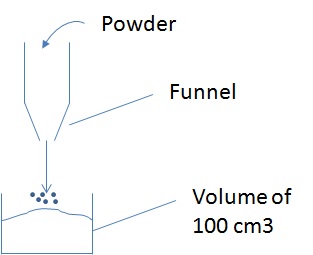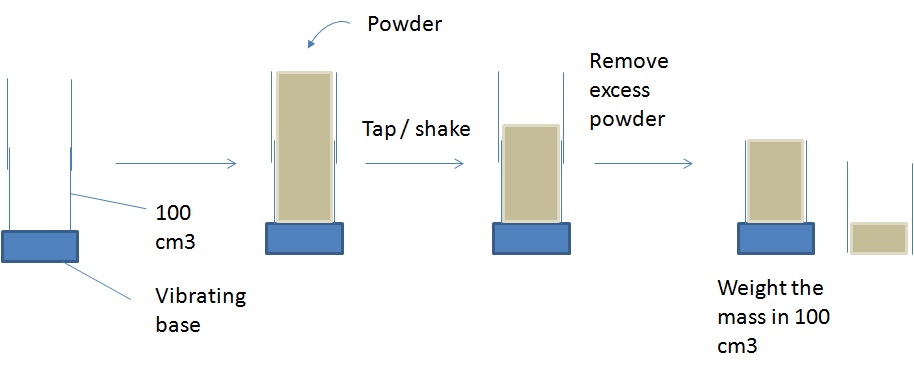
Bulk Density : an overview
Bulk density : Definition, measurement, calculation, application
What is the bulk density of powders ? How to measure bulk density ?
Tapped and loose bulk density
Follow us on Twitter ![]()
Question, remark ? Contact us at admin@powderprocess.net
| Section summary |
|---|
| 1. Definition of
bulk density |
| 2. Calculation of
bulk density |
| 3. Measurement of bulk density |
| 4. Applications |
| 5. Use of bulk density in process
design |
1. Definition of bulk density
What is the bulk density of a powder / bulk solids ?
Powder bulk density is the density of the bulk of the particles, included the voids in between each particles. 2 bulk densities are usually measured :
- Loose Density
- Tapped Density
Bulk solids density should not be confused with particle density and skeletal density : you can find more information on these 2 important characteristics there :
2. Calculation of bulk density
How to calculate bulk density ?

Equation 1 : Solids Bulk Density
3. Bulk Density Measurement
How to measure bulk density ?
When measuring the loose density, the powder must be in its aerated state.

Figure 1 : Measuring loose bulk density
When measuring tapped density, a step of powder compaction is necessary.

Figure 2 : Measuring tapped bulk density
The sample volume is shown to be 100 cm3 in the example above because it helps a quick calculation of the bulk density, however it could be in principle any volume provided the ratio of weight of the sample over the volume of the sample is done correctly.
Top
5 Most Popular
1.
Pneumatic transport design guide
2. Ribbon blenders
3. Powder mixing
4. Hoppers design guide
5. Measuring degree of
mixing
--------------
 --------------
--------------
Top 5 New
1. Continuous Dry Mixing
2. Mixing speed
3. Mixer cycle time
optimization
4. Batch
/ continuous mixing comparison
5. Energy Savings
4. Applications
Bulk density is used, among other purposes, to calculate the sizes of vessels in the process (hoppers, silos...)
Example
A weighing hopper must hold a maximum of 500 kg
The loose density of the powder dosed is 0.34 kg/l
The required useful volume of the hopper must be 500/0.34=1470
liters (be careful here to angle of repose of the powder to
calculate the total volume of the hopper)
5. Design - Use of bulk density in design
WARNING : the loose and tapped density are critical bulk powder properties and should not be confused when designing an installation. It can lead to process limitations. It is especially the case in the following cases.
Hopper design : after tipping, pneumatic transport, or basically movement of powder, the powder tends to be aerated and therefore takes its loose density value. If hoppers are designed according to tapped density, buffer volumes may be too small. When considering a product with a CARR Index of 20 which is common, the difference in between both bulk densities will be 20%, this can make the difference between a process that operates continuously... and a process that stops because the buffer size was too low to contain the right weight of powder. The powder in the hopper will tends towards the tapped density only with time or vibration, which will make the powder more compact.
Volumetric dosing : such dosing system is based on the assumption of a density of the powder, if it is different, the feeding in terms of kg/h will not be at target.
Filling : when filling material in packs, the estimation of the bulk density is critical, otherwise powder will not fit in the pack ! here again the loose bulk density must be considered (or some vibration must be applied during filling to admit more powder).